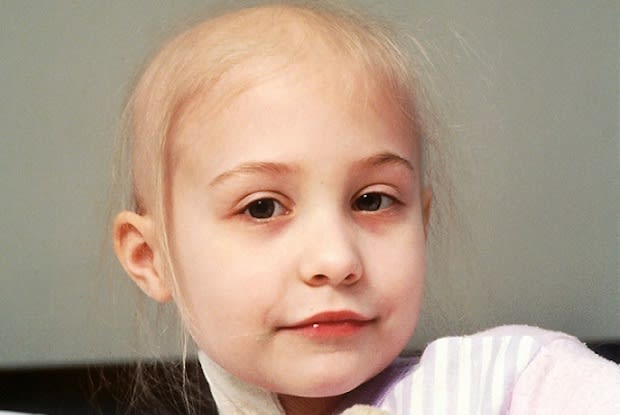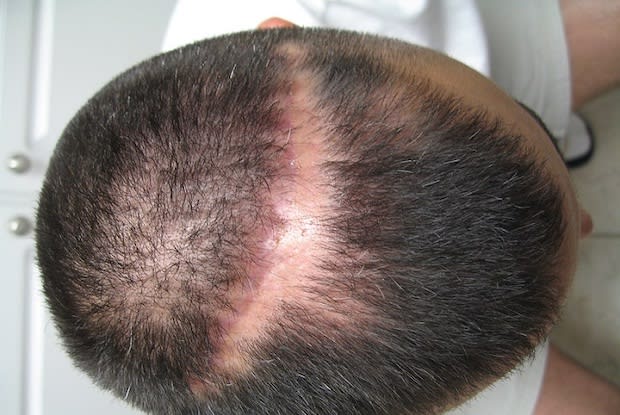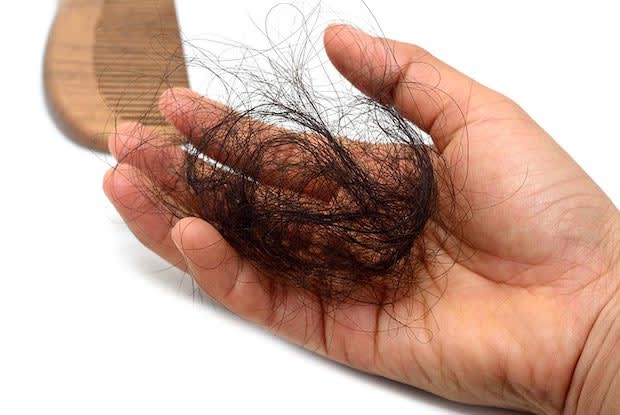Table of Contents
The Purpose of Hair
Human hair grows fairly quickly at a rate of 0.35mm per day, which equates to 0.5 inches per month or 6 inches per year. A healthy head of hair contains anywhere between 80,000 and 120,000 hairs on the scalp. Human hair serves many physiological and psychological functions.

Thermoregulation is one of the main functions of hair, as it helps to maintain temperature by retaining heat or preventing cold. Hair serves to protect the body from UV radiation. Furthermore, hair is considered a sense organ in humans. Human hair is lighter and thinner than hair in primates. Human hair has a psychological function, as an individual’s hair plays a role in his or her identity; this becomes especially evident in the case of hair loss disorders such as alopecia. [1]
Hair Loss Explained
The medical term for hair loss is alopecia. According to the American Academy of Dermatology, it’s normal to lose between 50 and 100 hairs a day. [2] Hair loss is associated with a loss of blood supply to hair follicles. [1] Blood supply to hair follicles is essential for hair growth and maturation. Hair loss is quite common, with 50 percent of men and women affected by hair loss by age 50. [3] Luckily, there are several medications available for treatment, including Propecia.
Hair loss conditions are separated into two categories: effluvium and alopecia. Effluvium is described as an increase in hair loss where patients note that their hair is falling out. Alopecia is described as hairlessness, with sections of complete hair loss. Hair loss can affect the scalp or the whole body. Hair loss can develop gradually over time or occur suddenly and can be temporary or permanent.
Although it is nearly impossible to count the number of hairs that have fallen out in one day, there are signs that indicate when hair loss is more than normal. You may be losing more hair than usual if you notice large clumps of hair in your shower drain or hairbrush. There may be thin patches of hair or small patches where the hair is no longer there. There are many underlying causes of hair loss, so if you are concerned, always consult a doctor.

Causes of Hair Loss
Hereditary
Hereditary hair loss is the most common type of hair loss worldwide and afflicts both men (male pattern hair loss) and women (female pattern hair loss); this type of hair loss is called androgenic alopecia. Hair loss is hereditary when you have inherited genes that cause the hair follicles to shrink and eventually stop working, thus halting hair growth. In men, the signs of hereditary hair loss often begin with a receding hairline or a small bald spot on the scalp. In women, a widening part or thinning of the hair may be due to hereditary hair loss.
Age
As you age, hair growth slows down and can cause hair loss. With age, hair follicles eventually stop producing hair, and the hair on the scalp tends to thin, lose its color, and recede at the hairline.
Cancer Treatment
Cancer treatment often involves chemotherapy and radiation treatment. These methods of treatment can cause complete hair loss after a few weeks in treatment. Once treatment is over, the hair begins to grow back after a few weeks or months.

Hormonal Changes
Hormonal changes or imbalances may cause hair thinning or loss, which is usually temporary. Reasons for hormonal hair loss include:
- Childbirth
- Pregnancy
- Discontinued use of birth control pills
- Menopause
- Polycystic ovary syndrome (PCOS)
Medical Conditions
Many different medical conditions can cause hair loss, such as:
- Alopecia areata: A disease where the immune system attacks hair follicles, causing hair loss.
- Scalp infection: Scalp infection can cause inflamed areas on the scalp.
- Scalp psoriasis: Scalp psoriasis is characterized by scaly, dry, red patches on the scalp and can lead to hair loss.
- Scarring alopecia: Is a condition that develops when inflammation destroys hair follicles, which prevents hairgrowth.
- STI: An untreated sexually transmitted infection, such as syphilis, can lead to hair loss.
- Thyroid disease: Thyroid problems can lead to thinning hair or hair loss in large clumps.
- Scarring: Diseases that cause scarring, such as lupus or lichen planus, can result in permanent hair loss due to scarring.

Nutrient deficiency
Nutritional deficiency can impact hair growth and structure. Sudden and extreme weight loss can cause hair loss. Deficiencies in these nutrients can cause hair loss:
- Iron
- Protein
- Biotin
- Zinc
Medication
Hair loss is a possible side effect of many medications. If you think your hair loss is due to medication you are taking, do not abruptly stop taking the medication before speaking with your doctor, as this can pose serious health risks.
Hair loss can be due to medications used to treat:
- Depression
- Heart problems
- Arthritis
- Cancer
- High blood pressure
Stress
Stress, such as a physical or emotional shock, can trigger hair loss. Certain major life events may cause stress-induced hair loss.
Types of shock that may trigger hair loss include:
- High fever
- Extreme weight loss
- Death of a loved one or divorce
- Recovery from an illness
Friction
Frictional alopecia is characterized by hair loss where socks, tight clothing, or boots rub up against the skin.
Poison
Being slowly poisoned can cause hair loss. Poisons that cause hair loss include:
- Arsenic
- Mercury
- Lithium
- Thallium
Accidental ingestion of rat poison, for example, contains large amounts of thallium. Thallium is water-soluble and tasteless, so residue from touching rat poison could be ingested or absorbed through the skin. [4]
Hair Care
Certain hair care techniques can lead to hair loss. If you color, relax or perm your hair, it can be damaging and lead to hair loss. Once hair follicles are damaged, hair cannot grow back and may cause permanent bald spots. Other reasons for hair loss include hairstyles that pull on the hair or scalp.
Symptoms
Hair loss symptoms show in a handful of ways. It can happen gradually or quickly and dramatically. A bald strip may appear within 1 to 2 days, clumps of hair may fall out during brushing, or perhaps all the hair on the head falls off.

Signs of hair loss include:
- Bald spots that grow in size
- Receding hairline
- Thinning of the hair and in women a thinning of the ponytail
- Widening part line of the hair
Hair loss can develop in other places than just the scalp, such as:
- Eyelashes
- Beard
- Eyelashes
- Pubic hair
- Nose hairs
Other signs of hair loss may include:
- Itching, burning, sensitivity in the area of hair loss
- Redness, swelling, sores
- Scaly patches of psoriasis
- Burning or stinging before hair loss
Diagnosis
To receive a diagnosis for a hair loss condition, always consult a doctor or registered dermatologist. Medical professionals are capable of recognizing the signs of hair loss, whether the cause is medical, environmental, or genetic. A doctor or dermatologist will assess the pattern of hair loss to determine its type and confirm a diagnosis. If it is suspected that an underlying medical condition is the cause of hair loss, a blood test or biopsy may be the best route of diagnosis. There are a number of steps to determine a diagnosis for each particular case of hair loss.
Medical History
Your doctor may ask a handful of varying questions to understand your medical history better. Some questions you may be asked include:
- When the hair loss began
- What kind of hairstyle you typically wear
- What is the pattern of hair loss
- Does hair loss run in the family
- Is there a history of other medical conditions
- If there was a recent pregnancy or childbirth
- What foods you commonly eat
- Any new stressors
Physical Exam
A physical exam may be done to check your scalp or other areas presenting hair loss for inflammation, redness, or sores. The doctor examines patterns of hair loss and the amount being lost.
Pull Test
In a pull test, a doctor or dermatologist selects small sections of hair, about 40 strands, from different locations on the scalp. If more than six hair strands fall out, this is known as active hair loss. Pull test is used to determine if you have any of the following types of hair loss:
- Telogen effluvium: hair falls out all over the scalp
- Anagen effluvium: rapid hair loss due to medical treatment
- Loose anagen syndrome: occurs mostly in young children where the hair is not firmly rooted in the follicle
- Early androgenetic alopecia: male or female pattern hair loss
- Advanced alopecia areata: an autoimmune disease where the immune system attacks hair follicles [5]
Tug Test
A doctor holds a section of hair with two hands, one at the root and one at the tip. As the doctor grasps the hair in two places, they then tug the hair to see if any strands break in the middle to determine brittleness and fragility of hair strands.
Card Test
In this test, a card is used to examine the health of hair strands and determine how many new hairs are growing. A part is created in the hair, and a small square card wrapped in felt is used. The card is placed against a section of the scalp to count new hair strands and examine broken and extremely thin strands.
Trichometric Analysis
Trichometric analysis is a computerized measurement tool that is used to analyze and take photos of aspects of the hair and scalp. A microscopic camera is used to magnify these images to have a detailed look and provides information such as the total number of hairs on the scalp and diameter of hairs.
Fungal Culture
A fungal culture is a test done in the laboratory to determine the presence of fungus in hair strands on scalp cells. This test is used to determine whether hair loss is due to a fungal infection such as scalp ringworm or tinea capitis.
Punch Biopsy
A punch biopsy test involves a pencil-sized device that is used to puncture the scalp to collect small tissue samples. The biopsy is sent to the lab for testing to determine the reason for hair loss.
Blood Test
If a nutrient deficiency, hormonal imbalance, or underlying condition is suspected to be the cause of hair loss, a blood test will be done. The blood test will be examined for iron deficiency, signs of hyper or hypothyroidism, and excess androgen levels, all of which can cause hair loss in different patterns and forms.
Treatment Options for Hair Loss
It may be the case that your hair re-grows on its own. Your doctor or dermatologist may recommend different methods of treatment outlined below.
Medication
Finasteride (Propecia)
Propecia is a prescription drug used to treat male pattern hair loss and should not be used by women or children. The function of Propecia is to prevent the conversion of testosterone to dihydrotestosterone (DHT) in the body. [6] If your doctor has prescribed you hair-loss medications like, Propecia or minoxidil, you can order them online through RxConnected to save money.
Minoxidil (Rogaine)
Rogaine is a medication used to help re-grow hair on the scalp. The function of rogaine is thought to dilate blood vessels on the scalp to stimulate hair growth. [6]
Other medications used to treat hair loss may include:
- Oral finasteride: A prescription medication for men with male pattern hair loss that inhibits the body’s ability to produce a particular hormone
- Antiandrogens: Medications that inhibit androgens (a hormone) to prevent female pattern hair loss
- Corticosteroids: Used to treat hair loss due to an autoimmune disease
- Antifungal medications: Used to treat hair loss due to a fungal infection [5]
Medical Procedures
Hair Transplants
There are two main hair transplant procedures to aid with hair loss. It's important to note that hair transplants are considered surgery and can be a painful and expensive experience. There are risks involved, so always consult your doctor.
Follicular Unit Transplantation (FUT)
FUT involves removing skin from the back of the scalp. The skin at the back of the scalp has an abundance of hair. Hair follicles are removed from this section. Then, hair follicles are re-inserted at the section of the scalp where there is excess hair loss.
Follicular Unit Extraction (FUE)
FUE focuses more on the individual hair follicles. In this procedure, individual hair follicles are removed from the scalp and inserted into the bald sections of the scalp.
Laser Treatment
Laser treatment is thought to be an effective treatment to reduce inflammation in follicles to prevent hair loss. While there are many physical treatments like transplants and laser therapy to treat hair loss, your doctor may prescribe hair loss medication like finasteride as a first line of treatment. To save on your hair loss medication, visit a Canadian online pharmacy like RxConnected today.
The content in this article is intended for informational purposes only. This website does not provide medical advice. In all circumstances, you should always seek the advice of your physician and/or other qualified health professionals(s) for drug, medical condition, or treatment advice. The content provided on this website is not a substitute for professional medical advice, diagnosis or treatment.

